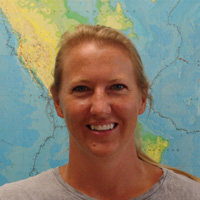 Effects of translocated clays on saprock mass balance, REE, and A-CN-K linear compositional trends, Santa Margarita Ecological Reserve, Peninsular Ranges, southern California, USARachel Errthum Friday, December 20th, 2013 |
| ABSTRACT
Petrologic, clay mineralogy, and geochemical data derived from an ~ 2-m-thick weathering profile developed on an ~125 Ma granodioritic to tonalitic pluton consistently indicate that the profile is composite, consisting of an older ~1.5 m thick section of saprock and a younger ~0.5 m section of soil. The primary element of the older section of saprock is a moderately well-developed crack system lined with kaolinitic clay. In p(A)-p(CN)-p(K) space, saprock data cluster relatively tightly about a compositional linear trend that is consistent with mixing kaolinitic clay and unweathered bedrock. In contrast, samples derived from the overlying soil samples do not plot along this trend above the cluster of saprock samples, and therefore cannot be the direct source of the kaolinitic clay lining the crack system. Such a conclusion implies that the saprock system is much older and may have been much thicker prior to erosional exhumation. Given the current height of the corestone (tor) at the sampling site, the minimum thickness of the regolith that may have been removed is ~20 m. Mass balance data suggest that the regolith that once lay above the saprock sampled during this study was intensely weathered. Moreover, the lack of accumulation of Ca, Na, and K mass in the saprock system suggests that these elements were likely transferred completely out of the regolith and into the ground water system. Such behavior implies the presence of considerably water, a characteristic that does not exist in the current climate at SMER. A number of arguments are developed that suggest that the saprock system that we studied may represent the vestiges of what was once a 20+ m thick section of regolith that developed within a sub-tropical to tropical environment during the Paleocene. |

